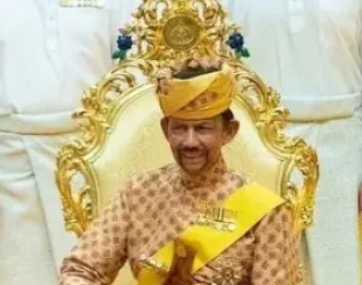With an estimated fortune of $30 to $50 billion, Sultan Hassanal Bolkiah has lived as a symbol of unquestionable sovereignty combined with incredible wealth. Brunei’s oil and gas deposits are a major source of his wealth, and throughout his rule, those resources have been transformed into palaces, expensive cars, artwork, and international recognition. His wealth scale works incredibly well to both astonish supporters and stoke criticism. Istana Nurul Iman, his home, is still a marvel of architecture, a 200,000-square-meter palace that is the biggest residential palace ever built.

With 1,788 rooms, 257 bathrooms, five swimming pools, and a dining hall that can accommodate 5,000 people, the mansion itself reads like a complex story of grandeur. A mosque, garages for hundreds of cars, and even a climate-controlled stable for 200 polo horses are all part of it. In Brunei, this magnitude is a commonplace reality, but it resembles the ideal of royal homes in movies. His income has always been intricately linked to opulent architecture and conspicuous authority, as seen by the $1.4 billion building expenditure in the 1980s.
Sultan of Brunei – Bio and Wealth Overview
| Category | Details |
|---|---|
| Full Name | Hassanal Bolkiah Muiz’zaddin Wad’daulah |
| Title | Sultan of Brunei (29th Sultan) |
| Date of Birth | July 15, 1946 (Age 79) |
| Place of Birth | Istana Darussalam, Brunei Town, Brunei |
| Reign | October 5, 1967 – Present |
| Coronation | August 1, 1968 |
| Net Worth | Estimated $30–50 billion |
| Main Residence | Istana Nurul Iman – largest residential palace globally |
| Occupation | Sultan, Prime Minister, Minister of Defense, Finance, Economy, Foreign Affairs |
| Notable Assets | 7,000+ luxury cars, private jets, $70m Renoir painting, gold Rolls-Royce |
One of the Sultan’s most well-known status symbols is his collection of automobiles. He reportedly owns over 7,000 cars, including 380 Bentleys, 450 Ferraris, and 600 Rolls-Royces, valued at $5 billion. His desire for exclusivity is evident in his collection of rare vehicles, such as the Ferrari 456 GT Venice, of which there are only seven. Among these, a $14 million gold-plated Rolls-Royce is a striking example of his lavish preferences. This nearly museum-quality collection demonstrates not only his passion for automobiles but also how he uses opulent artifacts to preserve history.
With a Boeing 747-400 that has been modified with gold fittings and is worth around $400 million, in addition to other jets and helicopters, his wealth is evident in the sky. This fleet of aircraft demonstrates how he sees travel as an opportunity for luxury rather than a necessity. Although he uses his fortune differently, he is frequently compared to Saudi royalty. Others invest money in sovereign wealth initiatives, while Bolkiah makes his fortune clearly personal, attracting interest and admiration.
His love of great art extends beyond automobiles and airplanes; he spent $70 million on Renoir’s Young Girls at the Piano, joining the ranks of famous collectors like Steve Wynn and Jay-Z. His unusual habits include paying $20,000 for each haircut to have his barber fly in from London—a detail that made him renowned worldwide. It reflects, but goes beyond, stories of Hollywood opulence, showing how his spending capacity constantly outstrips celebrity excess.
This image of affluence is made more nuanced by his personal history. Bolkiah, who was born in 1946, had his training at the Royal Military Academy Sandhurst, and holds certifications as an airplane and helicopter pilot. He blends traditional royal privilege with contemporary skills. His leadership responsibilities go well beyond mere symbols. He unifies almost all state power under his leadership as Prime Minister, Minister of Defense, Finance, and Foreign Affairs—a arrangement that is uncommon in modern administration but extremely effective for preserving stability.
Because of this stability, Brunei has been able to offer its inhabitants free healthcare, education, and subsidies—all of which are very advantageous results of its oil wealth. However, his wealth provokes discussions about inequality on a global scale. His extravagant lifestyle, which is frequently likened to that of Jeff Bezos or Elon Musk, is perceived as being disconnected from the everyday lives of regular people. But Brunei’s lack of internal strife shows that his leadership has been unusually successful in striking a balance between luxury and the wellbeing of the country.
There have been scandals. One of the most notorious royal disputes in Asia began when his brother, Prince Jefri, was suspected of embezzling billions of rupees. Their aftermath served as a reminder of how excess can weaken even familial ties and brought attention to the dangers of unrestricted access to wealth. The media extensively covered the Sultan’s marriages, especially his divorces and the fact that Pengiran Anak Saleha, his first wife, is still Queen Consort. Similar to the worldwide obsession with the royal family of Britain or the princes of Monaco, these intimate tales, despite their contentious nature, contribute layers to his public persona.
His kids—Prince Abdul Mateen in particular—now serve as contemporary representatives of Brunei’s royal family, posting glimpses of their way of life on the internet. Mateen’s extravagant ten-day wedding in 2024, which was reminiscent of Bollywood-style festivities, attracted world leaders. It illustrates how, in a time characterized by media spectacle, riches is not only inherited but also constantly performed for audiences throughout the world, shaping ideas of monarchy.
The Sultan’s rule provides more comprehensive perspectives on world wealth and royalty. His fortune symbolizes hereditary sovereignty linked to natural resources, in contrast to billionaires who established empires via innovation. This contrast highlights how wealth becomes both incredibly durable and highly contentious when combined with absolute control. His way of life exemplifies the dichotomy of contemporary monarchy: it is praised for its opulence, criticized for its inequity, but it is tenacious in its rule.
